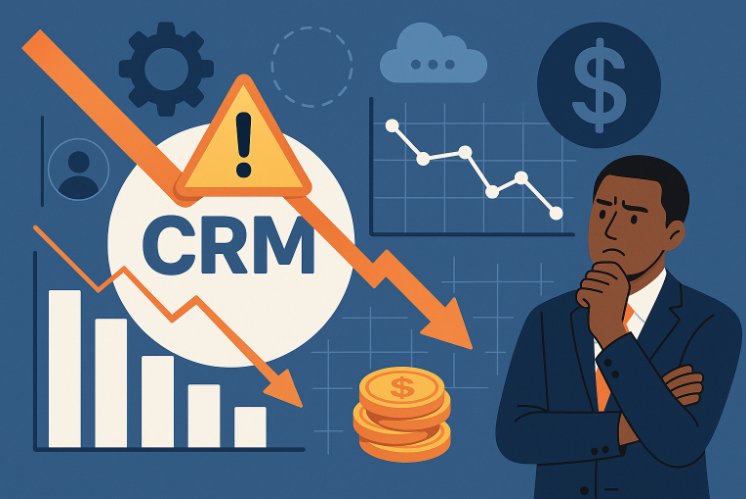The Hidden Cost of Poor CRM Adoption in Capital Market Firms

Client Relationship Management (CRM) systems have become indispensable tools for modern enterprises, promising to streamline processes, improve client interactions, and boost revenue development. With the worldwide CRM industry expected to reach $262.74 billion by 2032, businesses are spending extensively on these systems to acquire a competitive edge.
However, a worrying reality lurks behind these great market figures: CRM failure rates now vary between 30% and 70%, with poor CRM adoption being the primary cause.
When your CRM becomes pricey shelfware rather than a powerful business driver, the ramifications go far beyond unused licensing costs. This article investigates the true costs of poor CRM adoption and offers actionable ways to guarantee your organization reaches the full potential of its CRM investment.
In capital markets, relationships drive revenue. From managing institutional sales to tracking deal pipelines, CRM systems are supposed to empower firms to stay organized, compliant, and competitive. But here’s the problem: CRM adoption often falls flat, especially in complex, high-stakes environments like capital markets.
Despite millions spent on CRM implementation, many firms still suffer from low usage rates, poor data quality, and disengaged front-office teams. The result? Lost opportunities, regulatory risks, and a system that becomes a liability rather than an asset.
This article uncovers the hidden costs of poor CRM adoption, why capital markets firms can’t afford to overlook it, and how to avoid the pitfalls of adopting underperforming CRM solutions.

Why CRM Adoption Fails in Capital Market Firms
While CRM adoption in enterprises is a common challenge across industries, capital markets face unique hurdles:
1. Complex Workflows
Institutional sales, trading desks, and research teams don’t follow simple sales cycles. Their workflows are multi-party, multi-channel, and real-time, making standard CRMs a poor fit without customization.
2. User Resistance
Bankers and sales teams often view CRM tools as administrative burdens, especially when the system feels like a compliance tracker rather than a deal enabler.
3. Difficult-to-Use CRM Adoption
When CRMs are unintuitive or poorly integrated with daily workflows (like Bloomberg chats, Excel models, or call notes), adoption drops. A difficult-to-use CRM adoption curve leads to incomplete data, workarounds, and disengagement.
4. Lack of Training and Support
Many CRM rollouts focus on the tech stack, not the human factor. Without proper onboarding, real-time support, and role-specific training, CRM usage stays minimal.
The Hidden Costs of Poor CRM Adoption
Poor CRM adoption isn’t just an IT issue it’s a business problem with direct financial consequences. Here’s what’s really at stake:
1. Missed Revenue Opportunities
If client interactions, deal pipelines, and relationship insights aren’t logged consistently, firms lose:
- Cross-sell and upsell opportunities
- Follow-up chances after research distribution
- Deal pipeline visibility, leading to delayed execution
- Relationship management continuity when team members move on
This leads to slower deal velocity and lost commissions.
2. Data Inaccuracy and Decision Blind Spots
The quality of a CRM depends on the data it contains. When usage is low:
- Client profiles remain outdated
- Contact hierarchies become inaccurate
- Engagement metrics are missing
- Revenue forecasting becomes guesswork
Without reliable data, firms make misinformed strategic decisions.
3. Compliance and Regulatory Risks
In capital markets, compliance isn’t optional. A poorly adopted CRM increases risk exposure by:
- Losing track of client communications
- Missing material disclosures and disclaimers
- Lacking proper audit trails for deal negotiations
- Failing to capture MiFID II research entitlements or consent logs
This can lead to fines, reputational damage, and client mistrust.
4. Increased Operational Costs
When CRM tools aren’t fully adopted, teams create workarounds:
- Multiple spreadsheets
- Personal notes and isolated data silos
- Duplicated work across sales and operations teams
This not only wastes time but also creates inefficiencies that drain resources.
5. Low Employee Morale and Frustration
Adopting a CRM system that isn't working well is the fastest way to demotivate a staff. If the platform slows them down or adds no visible value, users disengage.
This leads to:
- Higher turnover in front-office roles
- Poor collaboration between desks
- Internal friction between sales, research, and compliance teams
The True Cost of CRM Implementation Without Adoption
Here’s the bottom line: a CRM that no one uses is worse than no CRM at all. The costs include:
When you add these up, the ROI of your CRM system quickly turns negative if adoption fails.
How to Improve CRM Adoption in Capital Markets
Reassessing CRM installation tactics is the first step towards increasing CRM adoption. Here’s how:
1. Choose a CRM Built for Capital Markets
Generic CRMs don’t cut it. Use a solution designed for:
- Complex account hierarchies (funds, managers, traders)
- Multi-channel client communications (email, calls, Bloomberg chats)
- Real-time deal tracking and syndicate workflows
- Research distribution and engagement tracking
Platforms like Insights CRM are purpose-built for CRM adoption in enterprises with complex capital markets.
2. Integrate Into Daily Workflows
CRM adoption skyrockets when it’s embedded in existing tools:
- Integration with Gmail or Outlook
- Mobile access for updates while on the go
- Dashboards for the research team and trading desk
- Task assignment and meeting note capturing that are seamless
The CRM should be the path of least resistance, not an extra task.
3. Simplify User Experience
Avoid overcomplicating forms, fields, or workflows. A difficult-to-use CRM adoption model leads to failure. Instead:
- Streamline data entry
- Use auto-tagging and AI-assisted note capture
- Provide intuitive dashboards for quick views
4. Provide Training and Real-Time Support
Don’t stop at onboarding. Live support assistance and ongoing CRM training:
- Reinforce best practices
- Answer workflow questions on the spot
- Show each role's -what's in it for me
5. Align CRM to Revenue Outcomes
Make the CRM a revenue enabler, not just a data tracker. Use it to:
- Give sales teams actionable insights
- Prior to churn, identify clients who are in danger
- Emphasize potential for cross-selling
- After the research, gauge client engagement
Adoption of CRM becomes ingrained in users when they observe a clear financial impact.
Final Thoughts: CRM Adoption Is a Strategic Priority
For capital market firms, the cost of poor CRM adoption goes far beyond technology waste—it affects revenue, compliance, client trust, and team productivity. The solution isn’t just to install better software—it’s to embed CRM into the firm’s DNA.
By investing in a CRM tailored to capital markets workflows and fostering a culture of usage, collaboration, and insight-driven engagement, firms can transform their CRM from a cost center into a competitive advantage.
Unlock Better CRM Adoption with InsightsCRM
InsightsCRM is purpose-built for capital markets. It’s not just about contact management—it’s about driving deals, improving collaboration, and enhancing client relationships with a platform teams want to use.
